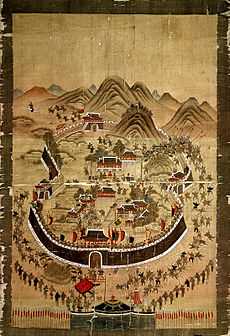Siege of Busan
| The Siege of Busan Castle | |||||||
|---|---|---|---|---|---|---|---|
| Part of Imjin War | |||||||
 The Siege of Busan Castle |
|||||||
|
|||||||
| Belligerents | |||||||
| Japanese Army | Korean Garrison | ||||||
| Commanders and leaders | |||||||
| Konishi Yukinaga So Yoshitoshi | Jeong Bal† Yi Jeong-hyeon Pak Hong |
||||||
| Strength | |||||||
| at least 15,000 men | 4000-8000 defenders According to Louis Frois, 600 soldiers | ||||||
| Casualties and losses | |||||||
| Unknown | 3000-8000 defenders i.e. Nearly all defenders | ||||||
| |||||
The Siege of Busan was a battle fought at Busan on April 13th-14th, 1592, between Japanese and Korean forces. Along with Tadaejin, Busan was the site of the first battle in the Imjin War. This battle marked the beginning of a long war on the Korean peninsula.
Battle

To establish a beachhead and control Busan shores, a strategy was planned based on the local knowledge of So Yoshitoshi, lord of Tsushima. The plan consisted of dividing their forces and leading simultaneous attacks against the fort, and subsidiary harbor forts of Tadaejin and Seopyeongpo.
Early on the morning of May 24, 1592 (Tenshō 20, 4th month, 13th day, by the Japanese lunar calendar), So Yoshitoshi attacked within the main city walls of Busan, while Konishi Yukinaga led the assault on the harbor fort of Tadaejin.
The Japanese overwhelmed the defenses by scaling the walls under cover of the arquebuse fire. The Koreans retreated to the second line of defense after the surprise attack of So Yoshitoshi. General Jeong Bal (Hangul: 정발, Hanja :鄭撥) regrouped his archers and counterattacked. By now, the Koreans had retreated to the third line of defence. After hours of fighting, the Koreans ran out of arrows. The Japanese were taking losses and regrouped to attack again.
Jeong Bal was shot and killed. Morale fell amongst the Korean soldiers and the fort was overrun at around 9:00 in the morning--nearly all of Busan's fighting force was killed. The Japanese massacred the remaining garrison and noncombatants. Yoshitoshi ordered his soldiers to loot and burn valuable items.
The Japanese army now occupied Busan. For the next several years Busan would become a supply depot for the Japanese. The Japanese continued to supply troops and food across the sea to Busan until Korean Admiral Yi Sun-sin attacked Busan with his navy.
Aftermath
With the fall of Fort Busan, the First Division of the Japanese Army completed its first objective. However, a few miles to the north of Busan lay the fortress of Dongnae; its garrison was a threat to the newly established beachhead. Early next morning, So Yoshitoshi led his wearied troops to attack Fort Dongnae.
These series of lightning-like attacks marked the beginning of the Seven Year War.
See also
- Castles in Korea
References
- Stephen Turnbull, "Samurai Invasion - Japan's Korean War 1592-1598", Cassel & Co, 2002